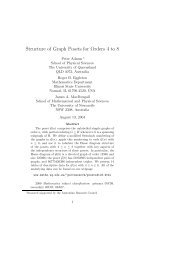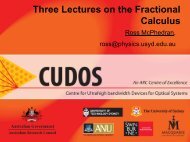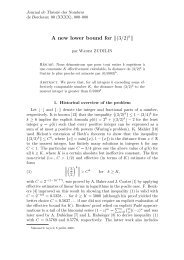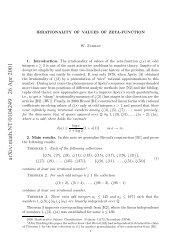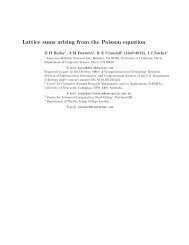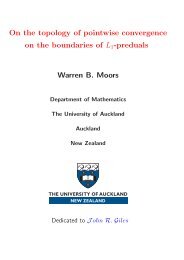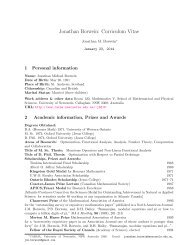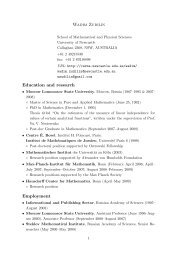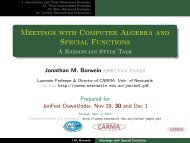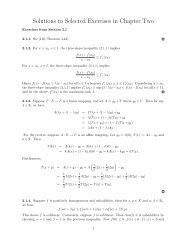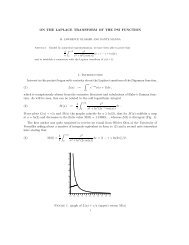QUADRATIC CONVERGENCE OF THE TANH-SINH ...
QUADRATIC CONVERGENCE OF THE TANH-SINH ...
QUADRATIC CONVERGENCE OF THE TANH-SINH ...
You also want an ePaper? Increase the reach of your titles
YUMPU automatically turns print PDFs into web optimized ePapers that Google loves.
4 JONATHAN M. BORWEIN AND LINGYUN YEIn the sequel we shall use the following lemma, a version of which is given withoutproof in [1]. We set{ −πi, Im z > 0(2.4) Ψ(z) :=πi, Im z < 0.Lemma 2.3. [1, Lemma 2]) Suppose that α and h are positive real numbers andf is a function satisfying the following conditions:(1) f is analytic on the closure of the strip S α = {−α < Im z < α}∫ a+iα(2) lim a→±∞ a−iα |f(z)|dz = 0(3) ∫ ∞−∞ f(x)dx and ∑ ∞n=−∞f(nh) exists.Then∫ ∞f(x)dx = 1 ∫f(z)Ψ(z) dz.−∞ 2πi ∂S αMoreover,∞∑h f(nh) = 1 ∫f(z) π cot πz2πi ∂S αh dz.n=−∞Proof. First, we consider integrating f on the boundary of rectangle A := {z :−α < Imz < α and − a < Rez < a} as shown in Figure 2. Since f is analytic onA, we have∫ ∫ a ∫ ∫f + f = − f − fC1 −aC21 C41and∫C3Combining these two equations gives∫ af = 1 ( ∫ ∫ ∫− f + f −−a 2 C1 C3∫ a ∫ ∫f − f = − f − f.−aC22 C42C21∫ ∫ ∫ )f − f + f + f .C41 C22 C42Letting a → ∞, by the condition 2. of the hypotheses, ∫ C21 f, ∫ C41 f, ∫ ∫C22 f andf will each converge to zero. Thus, we getC42∫ ∞f(x)dx = 1 ∫f(z)Ψ(z) dz.−∞ 2πi ∂S αThe function f(z) π cot(πz/h) has poles at nh for integer n with residues hf(nh).According to the residue theorem, we have∫1N∑f = h f(nh)2πin=−∞C1+C2+C3+C4n=−Nwhere N is the largest integer such that Nh < a and C2 = C21 + C22, C4 =C41 + C42. Letting a → ∞, we obtain∞∑h f(nh) = 1 ∫f(z)π cot πz2πi ∂S αh dz,as claimed.More generally, similar arguments will establish:□



